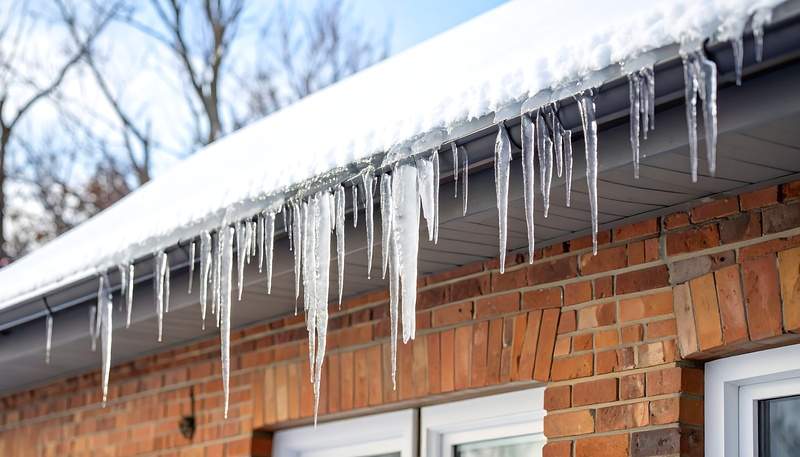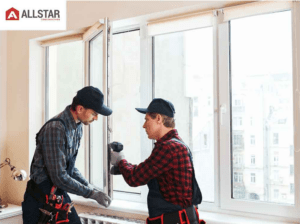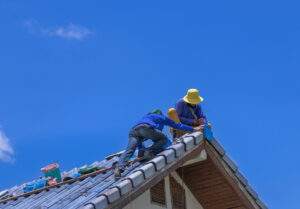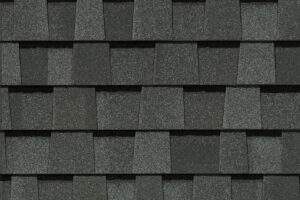Fargo homeowners know that winter weather isn’t forgiving. Months of freezing temperatures, high winds, and heavy snow can test every part of your home’s roof. Even small issues—like a few loose shingles or a clogged gutter—can turn into costly water damage once ice and snow take hold. The good news is that with the right preparation, your roof can withstand the coldest months and protect your home all season long.
Before the first storm arrives, here’s what to look for—and how to make sure your roof is truly ready for Fargo’s harsh winter weather.
Key Takeaways
- Fargo’s long winters bring snow, ice, and cold that can reveal roof problems needing quick attention before damage spreads.
- Proper insulation and ventilation keep roofs protected from ice dams, leaks, and moisture that threaten home safety.
- Clean gutters, trimmed branches, and clear debris help roofs handle snow buildup and freezing temperatures safely.
- A professional inspection gives peace of mind that the roof is sealed, sturdy, and ready for harsh winter weather.
Look for Signs Your Roof Isn’t Ready for Winter
Before Fargo’s cold weather sets in, it’s smart to take a closer look at your home’s roof. The combination of snow, ice, and fluctuating temperatures can reveal problems that went unnoticed during warmer months.
Here are the key issues to watch for before the first major snow arrives.
Missing or Damaged Shingles
When cold weather arrives in the Red River Valley, even a few missing shingles can create vulnerable spots that invite moisture into your home’s roof. Fargo’s harsh winter weather often worsens minor damage, especially when wind or hail has loosened asphalt shingles or lifted the edges near roof penetrations.
If you notice cracked, curled, or loose shingles after fall storms, these weak points can quickly turn into potential leaks once snow accumulation begins.
Roof maintenance before winter is essential to keep your roof ready and avoid expensive repairs when winter storms hit.
Ice Dams Forming Along the Roof Edge
Ice dams form when warm air from the attic space melts snow on the roof, and the runoff refreezes at the eaves. As this cycle repeats, water can back up under roof shingles and soak into the roof decking, causing hidden water damage.
Proper insulation and roof ventilation are key to preventing ice dams, as both help maintain a consistent temperature across your home’s roof.
In Fargo, where temperatures drop rapidly once winter arrives, homeowners who neglect attic ventilation often face roof leaks and damaged interiors from trapped meltwater.
Clogged or Damaged Gutters
Clogged gutters filled with pine needles, falling leaves, and other debris buildup prevent water from draining properly, especially during heavy snowfall. As snow arrives and melts, these blockages freeze into solid ice, bending gutters and pulling on fascia boards. This can also lead to roof damage if melting snow has nowhere to go.
To stay ahead of problems, clean gutters thoroughly using a garden hose or leaf blower, and install gutter guards to stop pine needles from clogging downspouts.
Keeping rain gutters clear helps prevent leaks and improves overall energy efficiency by directing meltwater safely away from your home’s foundation.
Improper Attic Ventilation
Improper ventilation can cause heat and moisture buildup in your attic insulation and space. In Fargo’s colder months, this warm air rises, melting snow unevenly and contributing to ice dams. When ventilation is limited or blocked, condensation forms beneath the roof decking and may lead to mold, rot, or compromised insulation.
Checking attic ventilation should be part of your seasonal maintenance routine every year.
A professional roofing company can determine if your roof ventilation is installed correctly and balanced to keep interior temperatures stable through the winter.
Sagging or Uneven Roof Lines
Sagging areas or uneven ridges on your home’s roof often signal deeper issues like moisture damage, weakened roofing materials, or structural strain from excess snow.
In Fargo, where heavy snow and freezing rain are common, these problems can worsen quickly. Most roofs can handle normal winter weather, but excess snow left on the surface increases stress on roof trusses and decking.
If you see dips in the structure or uneven lines, contact a roofing professional immediately to prevent long-term damage. Using a roof rake after storms can also help minimize snow accumulation before it becomes too heavy.
Schedule a Professional Roof Inspection
Before harsh winter weather hits, scheduling a professional inspection ensures your roof for winter is structurally sound and properly sealed. A qualified roofing professional can identify vulnerable spots such as damaged shingles, cracked flashing, or gaps around roof penetrations.
At Allstar Construction, our CertainTeed-certified inspectors specialize in roof maintenance and sealing gaps before the colder months set in. We also check roofing cement and flashing to ensure every surface is installed correctly.
Preparing early helps prevent leaks, extend the life of your roofing materials, and keep your home’s interior dry all winter long.
Clean Gutters and Install Gutter Guards
To prepare your roof for winter, clean gutters thoroughly and remove debris buildup from nearby trees. Clogged gutters and downspouts trap water that freezes during heavy snow, increasing the risk of ice dams. Use a garden hose or leaf blower to remove pine needles and other debris.
Once clean, install gutter guards to prevent future blockages—an especially valuable upgrade in Fargo neighborhoods surrounded by mature trees.
This simple step helps maintain proper drainage and prevents water damage when snow melts during winter storms.
Check and Add Insulation
Attic insulation plays a critical role in maintaining a consistent temperature throughout your home’s roof. In Fargo’s cold weather, proper insulation keeps heat inside your home, helping you stay warm and improving energy efficiency.
Homeowners should check attic insulation for uneven coverage or signs of moisture.
Adding or upgrading insulation before winter arrives helps prevent ice dams and reduces heating costs. A professional inspection can verify whether your attic insulation meets local standards for the upper Midwest’s colder months.
Improve Roof Ventilation
Adequate roof ventilation ensures air flows evenly through the attic space, preventing moisture buildup and maintaining stable temperatures that reduce ice dam formation.
In Fargo’s extreme climate, ensuring that ventilation is installed correctly helps protect roof decking and insulation from condensation.
A professional roofing company can recommend the right balance of ridge vents, soffit vents, and exhaust fans to improve airflow. This step complements proper insulation and reduces the chance of roof damage caused by trapped humidity during the coldest parts of the year.
Remove Overhanging Branches and Debris
Low-hanging branches and overhanging trees can scrape roof shingles or break under the weight of ice and snow. When snow arrives, falling limbs can damage roofing materials or even puncture the decking.
A USDA Forest Service tree-risk management manual notes that many branch failures stem from preexisting structural defects exacerbated by ice and wind, increasing hazard potential. According to GAF, one of the nation’s leading roofing manufacturers, even light contact from tree branches can wear away protective shingle layers and shorten a roof’s lifespan over time.
Trimming branches away from your home and clearing other debris from the roof surface helps prevent leaks and protects against algae growth and moss buildup.
For safety, use proper ladder safety techniques or hire a professional roofer for debris removal and pruning to prevent accidents during roof maintenance.
Prepare for Heavy Snowfall
Heavy snow and excess snow buildup are among the biggest challenges for homeowners in Fargo. Most roofs are built to handle normal winter storms, but constant snow accumulation adds significant weight.
Using a roof rake to remove snow safely from the ground helps prevent ice dam formation and minimizes stress on your roof. Metal roofs can benefit from snow guards to control sliding snow and protect gutters from damage.
Combining these steps with sealing gaps and using roofing cement where needed ensures your roof is ready to withstand the coldest conditions.
Stay Ahead of Winter Roof Damage
When winter arrives in Fargo, being proactive about roof maintenance can save your home from water damage, potential leaks, and roof repairs. For 45+ years, our crew has helped homeowners prepare their roofs for harsh winter weather with reliable inspections, insulation upgrades, and ventilation improvements.
Whether your roof is asphalt shingles or metal, our team ensures every system is installed correctly and built to last. Stay ahead of the season—schedule your professional inspection today and keep your home protected through the colder months.
Frequently Asked Questions
How do nearby trees affect how to prepare your roof for winter in Fargo?
Nearby trees drop branches and debris that trap snow and moisture. Trimming them before winter prevents roof strain, ice formation, and damage while keeping your roofing system clear and protected from entry points.
Should I check attic insulation even if my home uses asphalt shingles?
Yes. Even with asphalt shingles, heat can escape through poor insulation. When you check attic insulation, you help prevent ice dams, reduce energy loss, and extend your roof’s lifespan during Fargo’s harsh winters.
Can pine needles clog roof systems during Fargo’s winter months?
Yes. Pine needles clog gutters and downspouts, causing ice buildup and poor drainage. Professional gutter cleaning removes this debris, preventing leaks, moisture damage, and structural stress through Fargo’s long winter season.
What other entry points can cause roof leaks during winter in Fargo?
Flashing, vents, and skylights can weaken from temperature changes, forming an entry point for melting snow. A professional inspection seals vulnerable areas, preventing leaks and improving your roof’s durability through extreme weather.





